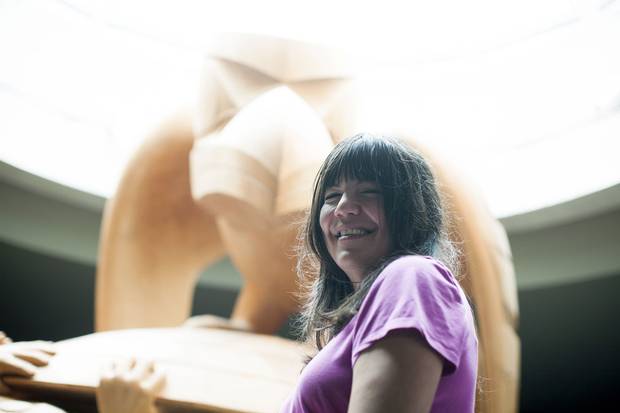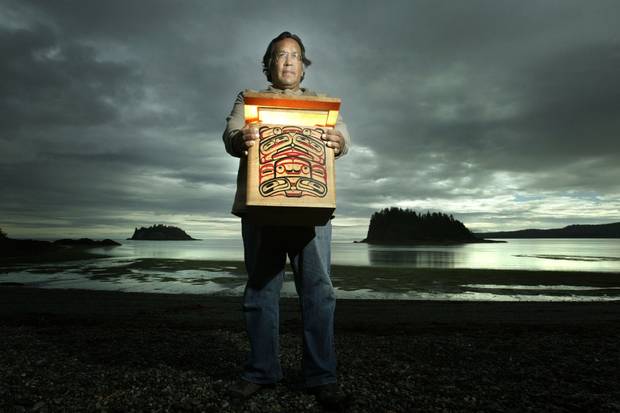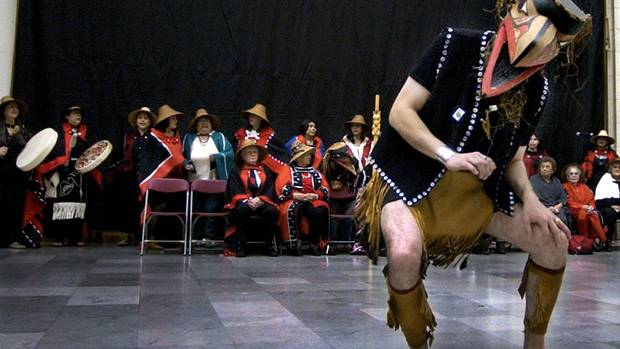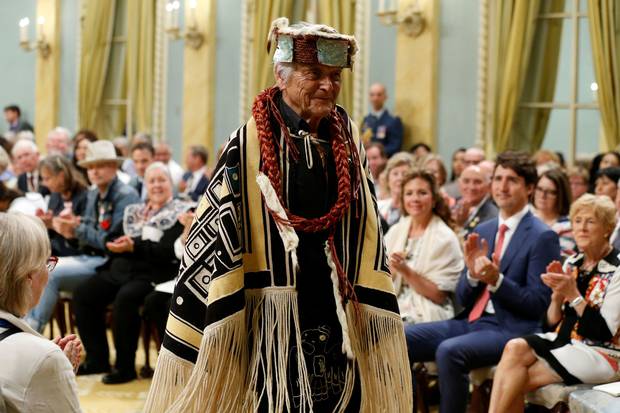After more than a century away from home, the mountain goat moon chest was allowed to live again. Liberated from museum storage in a foreign land, the iconic chest was wheeled out to the middle of a packed rec centre gym in Skidegate, B.C., on remote Haida Gwaii, as hundreds watched. The crowds were there for a historic potlatch when the surprise guest star stole the show. No protective glass, no roped-off borders – just a dolly separating the chest from the old-growth wood floor where the Haida play basketball. A treasure itself, the box was packed with more: 25 copper shields, important symbols of wealth in Haida culture, which were handed out that Easter weekend in a powerful ceremony.
"It was absolutely magical and transformative," says Nika Collison, who belongs to the Ts'aahl clan of the Haida Nation. "The chest itself wasn't only transformed from being in a basement for 100 years to being back in use, it was transformed into being everything it always was. And that transformed all of us in the room."
It was Ms. Collison's idea, as co-chair of the Haida Repatriation Committee, to bring the chest home to Haida Gwaii, a group of islands off the Northern British Columbia coast. And it was her smarts, passion and connections that helped to broker an extraordinary loan from the American Museum of Natural History (AMNH), which owns the item. She proposed it as a creative repatriation: The chest would not only be displayed at the Haida Gwaii Museum at Kay Llnagaay, where it is now, but first, the pioneering agreement would allow Guujaaw, the Haida artist, activist and leader, to use it in a potlatch marking his transition to Gidansda, hereditary chief of Skedans.
That AMNH agreed to her proposal was "huge," Ms. Collison says. "This has my colleagues' jaws dropping around the world."

Nika Collison stands in front of Bill Reid’s iconic sculpture The Raven and The First Men.
RAFAL GERSZAK FOR THE GLOBE AND MAIL
Its return, even if temporary, marks the beginning of a new chapter in the long history of Haida loss and, now, reclamation. After working for decades to bring home the remains of their ancestors – robbed from their graves and scattered to museums around the world – the Haida are preparing to enter the next phase of their massive repatriation efforts: They want their things back.
They know of more than 12,000 attributed Haida pieces in more than 130 museums. New research shows there may be many more; they've identified close to 200 institutions around the world.
Over decades, the relationship between museums and Indigenous people has shifted, and the question of the appropriate fate of ill-gotten First Nations' belongings has led to the forging of new paths and partnerships, such as the one that brought the mountain goat moon chest to Skidegate.
"We've put our dear friends on notice," Ms. Collison says, meaning museum officials with whom she has cultivated long-term relationships. "We will be moving forward with seeking the return of some of our cultural treasures, our belongings, our heirlooms."

Grizzly bears adorn the ends of the mountain goat moon chest.
AMERICAN MUSEUM OF NATURAL HISTORY
The mountain goat moon chest is one of thousands of artifacts that illustrate the richness of Indigenous culture and now illuminate a history of colossal loss.
"That chest is one of those statue of David-type iconic pieces within our nation," says Gwaai Edenshaw, Guujaaw's son.
It was carved before 1880 for Guujaaw's ancestor, a previous chief of Skedans, an ancient Haida village. There is a mountain goat on one side, a moon on the other and grizzly bears at the ends. It was acquired by AMNH in 1901. Before this spring, Guujaaw had only seen it in photos. "When I finally laid eyes on it, it was just more than it seemed. More than I expected, even," he says.
"Originally the chief intended it to be a grave box," he later adds, "but then he got an offer he couldn't refuse, I guess, and sold it."
In British Columbia, collecting of First Nations items reached a fever pitch after 1880, with what's come to be known as the Northwest Coast scramble. The competition was particularly fierce between three U.S. museums – AMNH, the Smithsonian and the Field Museum – and led to an exodus of treasures from B.C. to New York, Washington, Chicago and elsewhere.
There were straightforward sales, but Indigenous people were also manipulated, swindled and outright robbed. Funerary items were stolen from graves. Human remains were taken too, feeding anthropological, scientific – and often casual collectors' – curiosity about Indigenous people, believed to be at risk of extinction.
"It's always hard to look at the artifacts that are in museums because we knew how they got them and how long they'd been there," says artist Andy Wilson, who spent years on the Haida Repatriation Committee.
Many of the items were sold by their owners, but often under terrible circumstances and for a song. Populations were declining at alarming rates – the Haida in particular were devastated by smallpox – and the cultural oppression and economic marginalization resulting from the potlatch ban, enacted in 1885, was excruciating. People who have studied the matter say it is inaccurate, even patronizing, to remove all Indigenous agency from these sales, but experts including Ms. Collison add the legitimacy of the transactions should be examined through a contextual lens.
"So much of what was sold was done so under duress because of colonial law and social/economic marginalization," Ms. Collison states.
For First Nations, these are not simply artifacts; they are the embodiment of the culture. A totem pole is a history book; a spoon delivers not just soup, but stories.
When a halibut hook was returned to the Haida Gwaii Museum, an elder held it in his hands and out came the stories: about swimming out to the halibut before there were canoes, about the songs of thanks the Haida sing to the halibut, about the materials used before iron.
When the Haida have visited other museums to bring the remains of their ancestors home, they requested time with their treasures.
"We've always told the museum, we need to bring life back into them," Mr. Wilson says. During a trip to New York years ago, he spent time with the mountain goat moon chest. (There's a tiny photo of the two of them displayed at the Haida Gwaii Museum, a couple of galleries away from where the chest now sits.)
The effort to repatriate ancestors and the things they made is a crucial component of reconciliation.
"There are remains of thousands of First Nations people taken from the province which are today languishing in museum basements right across the world," says Jack Lohman, chief executive officer of the Royal BC Museum (RBCM). "So this is a priority and it's actually a huge injustice that needs to be corrected."

Andy Wilson, shown in Skidegate in 2003, holds one of the 150 traditional bentwood boxes holding Haida remains being repatriated by the Field Museum for burial on Haida Gwaii.
JOHN LEHMANN/THE GLOBE AND MAIL

Nika Collison sits in front of the Haida Longhouse at the UBC Museum of Anthropology in Vancouver. As co-chair of the Haida Repatriation Committee, she brokered the deal that brought the mountain goat moon chest to the Haida Gwaii Museum.
RAFAL GERSZAK FOR THE GLOBE AND MAIL
Before they began to turn their attention to artifacts, the Haida had already been through the process of bringing home the bones of more than 500 ancestors that had been exhumed and distributed to museums across the globe. The last burials, of about a dozen ancestors, are upcoming on Haida Gwaii. There is only one known ancestor still awaiting return, in British Museum's possession.
"It's a very emotional thing when you get to the museum and you see your ancestors in the cupboards," says Mr. Wilson.
In a hill overlooking Skidegate Inlet, in a private corner of the community cemetery, the remains of Haida ancestors are finally laid to rest. They are wrapped in little traditional button blankets made by schoolchildren on Haida Gwaii and placed in bentwood boxes made by Haida carvers.
Up in Old Massett, at another community cemetery, rows of white crosses mark the return of remains from Chicago, Oxford and elsewhere – "to forever remain on Haida Gwaii."
(Outside visitors are not allowed at the cemeteries; The Globe and Mail was there with Haida permission.)
The Haida had always planned a second phase of repatriation, both from museums in Canada and abroad. But it was a political speech a year ago on National Aboriginal Day, an infuriating incident for Ms. Collison, that served as the catalyst for the Haida to ramp their efforts back up.
At a media event at the Royal BC Museum, Premier Christy Clark stood in front of totem poles, demanding U.S. museums return ancestral remains and sacred artifacts. (She later pledged $2-million to the RBCM to lead the effort – and this funding was essential in mounting a repatriation symposium this past spring.)
Excerpts from Christy Clark’s 2016 news conference
Reading about the news conference, Ms. Collison was stunned. She had worked so hard to foster relationships with these museums and together they had achieved great successes. Why were the institutions being called out for bad behaviour when in fact they had been great collaborators? And why had the Haida not been informed about this ahead of time, or asked?
"It hit me in my heart and it turned my stomach over and over," says Ms. Collison, who begins to cry as she recounts the story. "It was like an assault on the ancestors that were already dead. … After all the work we're trying to do for them to bring them home and she's making grandstand announcements?"
Ms. Collison quickly set out to do damage control with the U.S. museums, with whom she has established excellent relationships. And then she made a decision. While Ms. Clark directed her wagging finger at museums south of the border, the Haida would focus their efforts at home – beginning with the site of the news conference, the RBCM.
"Perfect. The province is ready? Let's go to work. We'll be contacting you this fall. We are so excited to work on this passionate initiative for us since you paraded us around the media, we thank you for the invitation and we have responded by putting you on notice," Ms. Collison says.
The Haida will also focus initially on the Canadian Museum of History (CMH) in Gatineau.
Both institutions say they are eager to participate. "We welcome it," says Dean Oliver, director of research at the CMH. "It's an opportunity to do the right thing by the objects and the people for whom they resonate the most."

A Haida performer dances in a ceremony at Chicago’s Field Museum on Oct. 17, 2003, to mark the museum’s return of about 150 Haida human remains to the their descendants.
M. SPENCER GREEN/ASSOCIATED PRESS
Although historically museums benefited from (and were even built as a result of) the collecting of Indigenous belongings, more recently, institutions have enthusiastically partnered with First Nations to repatriate items – not because it is a legal requirement, but because it is the ethical thing to do.
"Archeologists and museum folks and others are trying really hard to repair the damage of their ancestors," says George Nicholas, chair of the repatriation committee for Simon Fraser University's archeology department. "A lot of things were done that were harmful, that were disrespectful – all in the name of science."
In Canada, museums repatriate items on a voluntary basis, rather than being dictated by law, with the exception of Alberta, which passed the First Nations Sacred Ceremonial Objects Repatriation Act in 2000. (The legislation currently only applies to the Blackfoot, but negotiations are now under way to expand it to include the Plains Cree, Assiniboine and Saulteaux in Alberta and Saskatchewan.)
The United States also has legislation in place, but it does not demand repatriation to other countries. So returns to Canada are done on a voluntary basis, with each request weighed individually. The American Museum of Natural History, Smithsonian and Field have all repatriated to Canada. In interviews with The Globe, each was keen to continue this work.
"Native people remind us that these bones were somebody. That these things weren't made by museums; they didn't originally belong to museums. They were made by and for and belong to native people," says Richard Kurin, acting provost for the Smithsonian. "Repatriation reminds us of that."
But there is also recognition on both sides that there is a complexity to museums' role as conservators - and ambassadors.
"Part of our job as an institution is to educate and to teach about the diversity and complexity of cultures and that … First Nations are alive and well, and that they're doing amazing things," the Field Museum's repatriation director Helen Robbins says.
The Hall of Northwest Coast Indians at AMNH has influenced artists ranging from Jackson Pollock to J.D. Salinger, as well as countless visitors.
"Given that we're in New York … the Hall represents a kind of a cultural embassy in a place which has the UN," says Peter Whiteley, curator of North American Ethnology, Division of Anthropology at AMNH. "This is a place where Native Northwest Coast nations in a sense are communicating to the world."
Museums have also been a resource for Indigenous artists themselves.
Tsimshian artist William White learned weaving largely by studying historic examples at museums. He now teaches what he has learned to others in a variety of First Nations settings. He sees this as a form of repatriation – repatriation of knowledge.
He says he has learned to deal respectfully with museum officials; he didn't years ago. "I felt, these pieces have all been stolen, we want them back, even though we have nowhere to put them. … As I matured, I realized we need to have a place to house them so we can be the custodians." He says the relationship is mutually beneficial. "When an anthropologist has an actual living person to talk to about something they're interested in, it expands their horizons."
In most cases, museums repatriate items as a result of a request. But occasionally, an institution initiates a return. The Museum of Vancouver has recently offered to send back a mortuary pole to Haida Gwaii. The pole, immortalized by Emily Carr in a 1912 painting, was cut down in 1958 for safety reasons and acquired by the museum in 1968; by then there was a huckleberry bush growing out of its top. It has since been in storage.
"The fact that they're doing this is so big, so big," says Kwiaahwah Jones, a Haida artist who is co-curating next year's show, Haida Now!, at the MOV. "They're putting pressure on other institutions to make things right. It's opening a door."
The MOV has an enormous First Nations collection – thousands of items, including hundreds from Haida Gwaii. While the museum has repatriated a few things, most have been packed away for decades.
"This can't stay in storage, it's too valuable," says MOV CEO Mark Richards. "You could build a national museum with a collection like this. So we're going to have to get this out of the darkness."
The totem offer is still being considered by the Haida, and they have a condition. "We don't want the pole this year," says Ms. Collison. "We have a great relationship with MOV, but we don't want this reparation to be associated in any way with Canada 150."

Chief Bill Cranmer takes part in a ceremony before being awarded the Sovereign’s Medal for Volunteers during a ceremony at Rideau Hall on June 19, 2017.
CHRIS WATTIE/REUTERS
Repatriations can be expensive. The Haida estimate their efforts have cost more than $1-million over the years.
Indigenous people from all over Canada face financial challenges as they work to retrieve their belongings, or consider doing so – and then ensure the items are properly housed.
In 1921, 'Namgis Chief Dan Cramner held an enormous potlatch outside Alert Bay, despite the ban. Police and the Indian Agent arrested 45 participants, about half of whom served time at Oakalla Prison as a result. Officials also confiscated hundreds of items, which wound up in museums and private collections.
"His potlatch was estimated to have [cost] about $30,000 and that was a lot of money in those days. And that in effect was just wiped clean, just like the government closing his bank account," says his son Bill Cranmer, the 'Namgis chief who helped found the U'mista Cultural Centre in Alert Bay (U'mista means the return of something important) and the Nuyumbalees Cultural Centre in Cape Mudge.
In June, Mr. Cranmer, now 78, was one of 29 people recognized by the Governor-General for Outstanding Indigenous Leadership. "Chief Bill Cranmer was instrumental in repatriating potlatch artifacts that were confiscated by the Canadian government in the 1920s," the citation read, in part.
But these centres cost money to run, so at the same time as he is being awarded in Ottawa for his work, Mr. Cranmer, along with the U'mista board, is fighting the federal government for support with a claim that goes back decades. The claim was rejected, but the nation saw an opportunity to revitalize the effort with the election of the Trudeau government. They want financial support to run U'mista, financial compensation for the chiefs who had to give up their things and an apology.
"It's the actions of the federal government in making our ceremonies illegal that resulted in this place being built in the first place," says Mr. Cranmer. "So they should have some responsibility for the cost of keeping it going."
Repatriations to Indigenous nations in Canada remain active. In June, the RBCM returned two masks to the Uchucklesaht on Vancouver Island, in addition to about 50 other items over the previous weeks. The Canadian Museum of History has also returned items to the Uchucklesaht, including a herring hook and a drum.
During a recent meeting with Indigenous and Northern Affairs Minister Carolyn Bennett, Smithsonian staff shared with the minister that the 150th anniversary of confederation was a good time to reaffirm its commitment to repatriation and re-energize its efforts.
That mountain goat moon chest will return to New York next year, but not before Guujaaw's sons Gwaai and Jaalen Edenshaw carve a replica that will remain on Haida Gwaii.
"In the excitement and all the work around the potlatch, I didn't get to dig right in and examine it, so I would really relish the opportunity to do that reproduction," says Gwaai Edenshaw.
"Anybody who goes through the motions of one of the old masters can learn a lot by it," Guujaaw says. "The more of those sort of things that remain with us the better. Sometimes you can't have the original, but you can have a copy of it."
Guujaaw has some work to do as well: A piece of the moon's nose, he has noticed, has broken off. He would like to fix it, this chest that connects him to his ancestors. First he'll have to get permission – from the museum.
The chest is on public view at the Haida Gwaii Museum at Kay Llnagaay until March, 2018.
INDIGENOUS PEOPLE: MORE FROM THE GLOBE AND MAIL





